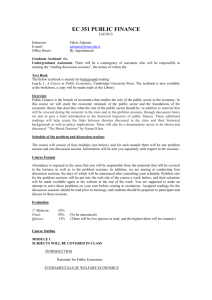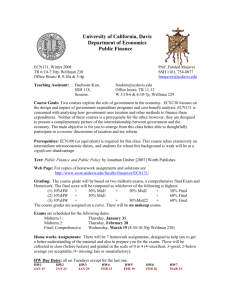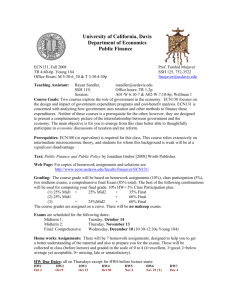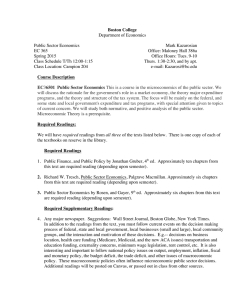Economics 131: Public Economics
advertisement
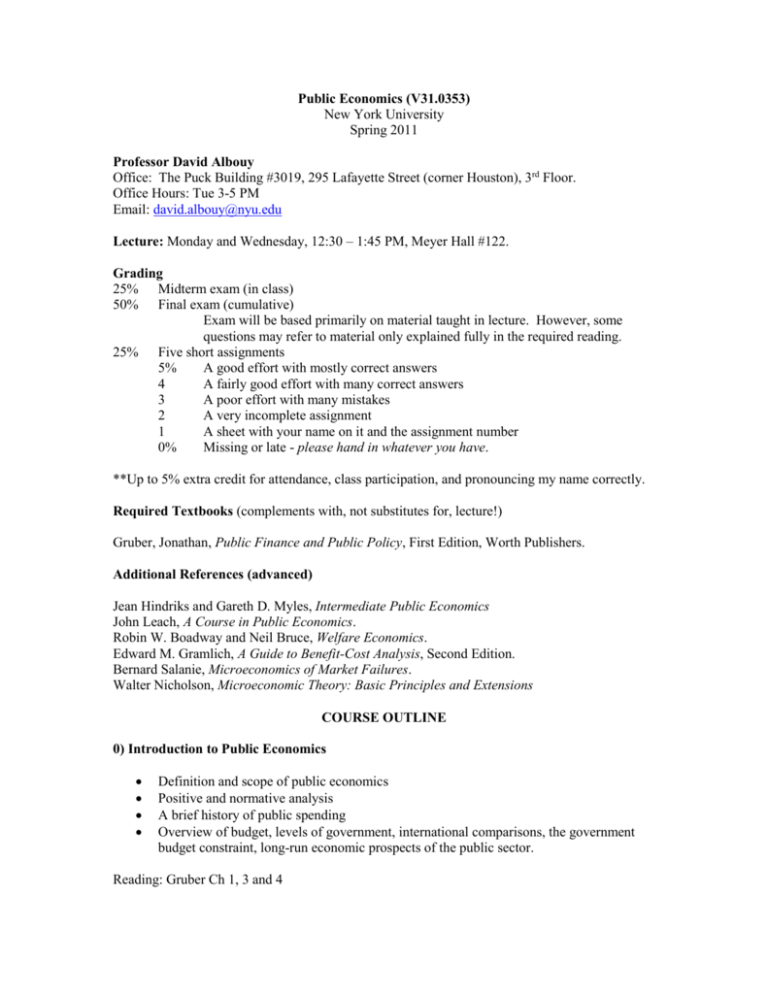
Public Economics (V31.0353) New York University Spring 2011 Professor David Albouy Office: The Puck Building #3019, 295 Lafayette Street (corner Houston), 3rd Floor. Office Hours: Tue 3-5 PM Email: david.albouy@nyu.edu Lecture: Monday and Wednesday, 12:30 – 1:45 PM, Meyer Hall #122. Grading 25% Midterm exam (in class) 50% Final exam (cumulative) Exam will be based primarily on material taught in lecture. However, some questions may refer to material only explained fully in the required reading. 25% Five short assignments 5% A good effort with mostly correct answers 4 A fairly good effort with many correct answers 3 A poor effort with many mistakes 2 A very incomplete assignment 1 A sheet with your name on it and the assignment number 0% Missing or late - please hand in whatever you have. **Up to 5% extra credit for attendance, class participation, and pronouncing my name correctly. Required Textbooks (complements with, not substitutes for, lecture!) Gruber, Jonathan, Public Finance and Public Policy, First Edition, Worth Publishers. Additional References (advanced) Jean Hindriks and Gareth D. Myles, Intermediate Public Economics John Leach, A Course in Public Economics. Robin W. Boadway and Neil Bruce, Welfare Economics. Edward M. Gramlich, A Guide to Benefit-Cost Analysis, Second Edition. Bernard Salanie, Microeconomics of Market Failures. Walter Nicholson, Microeconomic Theory: Basic Principles and Extensions COURSE OUTLINE 0) Introduction to Public Economics Definition and scope of public economics Positive and normative analysis A brief history of public spending Overview of budget, levels of government, international comparisons, the government budget constraint, long-run economic prospects of the public sector. Reading: Gruber Ch 1, 3 and 4 1) General Equilibrium and Welfare Economics Cardinal, ordinal, and intercomparable utility Utility possibility sets, social welfare functions, social planner’s problem, Pareto optimality, social welfare functions Consumer utility maximization and demand functions Market equilibrium and price determination Firm profit maximization and supply functions Consumer and producer surplus. First and Second Fundamental Theorems of Welfare Economics Planned versus market economies. Pigou and Hayek. Taxonomy of market failures Reading: Gruber, Ch 2 (including Appendix) 2) Imperfect Competition and Increasing Returns Marginal-cost pricing Minimum efficient scale and natural monopoly Rent-seeking. 3) Externalities and Public Goods Positive and negative externality, private versus external social costs and benefits The Coase Theorem, hold-up and assignment problems Corrective Pigouvian taxation Quantity and price regulation, tradable permits, economics of climate change. Pure and impure public goods, Samuelson’s Rule, vertical addition of demand curves Nash equilibrium, best response function, free-rider problem, coordination failure, market failure Charitable giving and crowd out Reading: Gruber, Ch 5, 6, 7 4) Cost-Benefit Analysis Hicks-Kaldor Compensation Principle/Test Present-discounted value; private and social discount rates Stated preference and contingent valuation Revealed preference; hedonic methods, and compensating differentials Shadow prices The value time, safety, human life, and cleaner air. Reading: Gruber, Ch 8 5) Social Choice and Political Economy Majority voting, Condorcet’s Paradox Arrow’s Impossibility Theorem Median voter theorem, Electoral competition, Citizen-candidate model Reading: Gruber Ch 9 6) Local Public Economics and Public Provision of Private Goods Advantages and disadvantages of federalism. Club goods and optimal club size Residential sorting and Tiebout equilibrium, benefit taxation, capitalization Mandated benefits Intergovernmental grants (e.g. matching, block), flypaper effect School finance, school choice and vouchers, private and social return to education. Reading: Gruber Ch 10, 11 7) Social Insurance, Adverse Selection and Moral Hazard Budgets and decision making under uncertainty and over time, expected utility model Consumption smoothing, risk aversion, actuarially fair insurance Asymmetric information, adverse selection, moral hazard Pooling and separating equilibria Overlapping generations, intergenerational equity Social Security reforms, universal health insurance. Reading: Gruber Ch 12, 13, 15, 16 8) Tax Incidence and Optimal Taxation Nominal versus real incidence. Deadweight burden of taxation Taxes on labor and Income and substitution effects Average and marginal tax rates, progressive and regressive taxation. Vertical and horizontal equity. Inverse-elasticity rule, production efficiency, equity-efficiency tradeoff Welfare programs “Iron Law” of welfare, means-testing, ordeal mechanisms Consequences of flat-tax reform Reading: Gruber Ch 17, 18, 19, 20, 21, 22.




